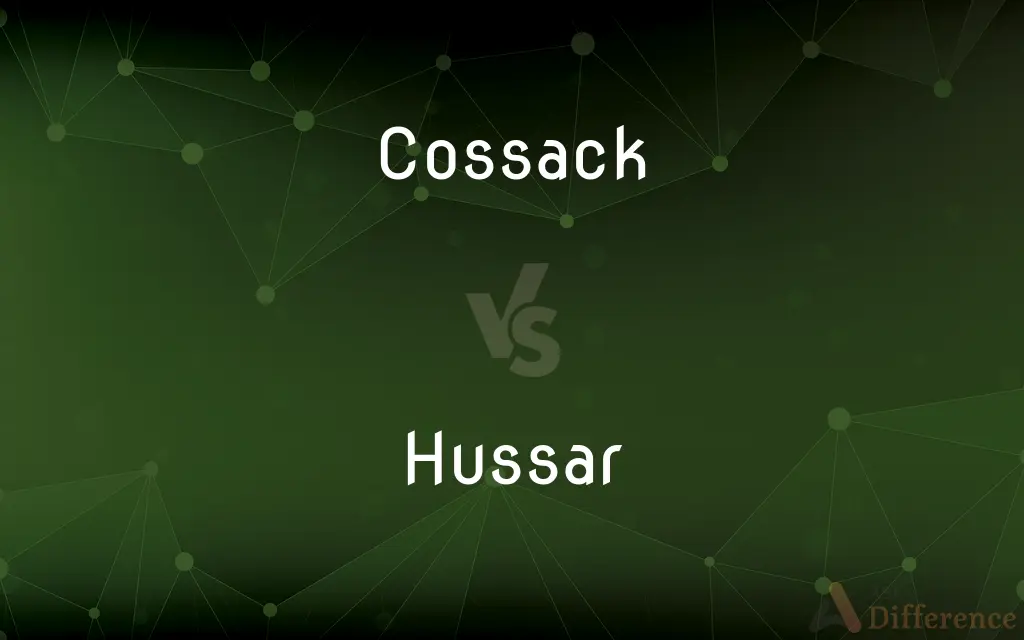Cossack vs. Hussar — What's the Difference?
By Urooj Arif & Fiza Rafique — Updated on May 2, 2024
Cossacks are East Slavic-origin warriors known for their military settlements and roles in Russian and Ukrainian history, while Hussars originated in Hungary as light cavalry used in medieval European armies.

Difference Between Cossack and Hussar
Table of Contents
ADVERTISEMENT
Key Differences
Cossacks are a group known for their unique social and military organization, originating from the regions now known as Russia and Ukraine. They formed autonomous communities known as "stanitsas" primarily focused on military service. On the other hand, Hussars began as Hungarian mercenaries before becoming a light cavalry unit adopted by various European armies, renowned for their daring and elaborate uniforms.
Cossacks played a key role in the expansion and security of the Russian Empire, often used as border guards and in military campaigns due to their knowledge of steppe warfare. Hussars, however, were characterized by their mobility and style of combat which emphasized speed, agility, and shock tactics in battle, spreading their influence across military strategies in Europe, particularly in Poland, Austria, and Prussia.
The typical attire of Cossacks included practical and durable clothing suited for their lifestyle on the steppes, such as sheepskin hats and long, flowing coats. In contrast, Hussars were famous for their flamboyant uniforms, featuring pelisses, tight dolmans, fur-trimmed cloaks, and feathered headdresses, which emphasized their elite status and role as shock troops.
In terms of weaponry, Cossacks were adept with a variety of weapons, including sabers, lances, and later firearms, reflecting their adaptability to different forms of warfare. Hussars, while also skilled in these weapons, were particularly noted for their use of the saber in lightning-fast cavalry charges, becoming symbolic of their approach to combat.
Cossacks today are recognized for their cultural heritage and have seen a revival in post-Soviet states as symbols of national identity and tradition. Conversely, the Hussar legacy remains largely historical and ceremonial, with modern units in some European countries preserving Hussar traditions mainly for ceremonial purposes and as a part of military heritage.
ADVERTISEMENT
Comparison Chart
Origin
East Slavic regions, notably Russia and Ukraine
Originated in Hungary, spread across Europe
Role in Military
Autonomous military communities, frontier guards
Light cavalry known for rapid, stylish combat
Typical Attire
Practical, rugged clothing suitable for steppe life
Flamboyant, elaborate uniforms with bright colors
Weaponry
Sabers, lances, firearms
Focused on saber for cavalry charges
Cultural Significance
Significant in Russian and Ukrainian identity
Mostly historical, with ceremonial units in Europe
Compare with Definitions
Cossack
Known for their military prowess and distinctive culture.
Cossacks have a unique dance that is popular at cultural festivals.
Hussar
Recognizable by their striking and elaborate military uniforms.
His Hussar uniform was adorned with braids and a plumed hat.
Cossack
Often employed as guards and in military services.
The Cossacks provided crucial support during the Tsarist regime.
Hussar
Emphasized speed and shock in combat, influencing European cavalry tactics.
The Hussar's tactics were studied in military academies.
Cossack
A member of a semi-military community from Eastern Europe, particularly Russia and Ukraine.
The Cossack rode across the steppe to patrol the border.
Hussar
Symbolic of military dash and bravery in European history.
The Hussars are often romanticized in historical novels for their bravery.
Cossack
Recognizable by their traditional dress, including high sheepskin hats.
He wore the traditional Cossack attire at the parade.
Hussar
A light cavalryman, originally Hungarian, noted for daring tactics.
The Hussar charged ahead of his unit, saber in hand.
Cossack
Today, they embody a revival of national tradition in post-Soviet states.
Modern Cossacks participate in reenactments and serve ceremonial roles.
Hussar
Their legacy continues in modern ceremonial units.
The ceremonial unit dressed as Hussars for the parade.
Cossack
A member of a people of Ukraine and southern Russia, noted for their horsemanship and military skill.
Hussar
A hussar ( hə-ZAR, huuz-AR; Hungarian: huszár, Polish: husarz, Serbo-Croatian: husar / хусар) was a member of a class of light cavalry, originating in Central Europe during the 15th and 16th centuries. The title and distinctive dress of these horsemen were subsequently widely adopted by light cavalry regiments in European armies in the late 17th and early 18th centuries.
Cossack
Relating to or characteristic of the Cossacks.
Hussar
A horseman of the Hungarian light cavalry organized during the 1400s.
Cossack
A member of a people of southern European Russia and adjacent parts of Asia. Many Cossacks served as cavalrymen in the armies of the czars.
Hussar
A member of any of similar, ornately uniformed European units of light cavalry.
Cossack
Alternative case form of Cossack
Hussar
(historical) A member of the national cavalry of Hungary, Croatia and Poland.
Cossack
One of a warlike, pastoral people, skillful as horsemen, inhabiting different parts of the Russian empire and furnishing valuable contingents of irregular cavalry to its armies, those of Little Russia and those of the Don forming the principal divisions.
Hussar
A member of the light cavalry of any of several European armies.
Cossack
A member of a Slavic people living in southern European Russia and Ukraine and adjacent parts of Asia and noted for their horsemanship and military skill; they formed an elite cavalry corps in czarist Russia
Hussar
Originally, one of the national cavalry of Hungary and Croatia; now, one of the light cavalry of European armies.
Hussar
A member of a European light cavalry unit; renowned for elegant dress
Common Curiosities
Can Cossacks and Hussars be seen in modern military contexts?
Cossacks are present in modern cultural and some official capacities in Russia and Ukraine, while Hussars mostly exist in ceremonial military units in Europe.
How have Cossacks influenced modern Russian culture?
Cossacks have influenced modern Russian culture through their revival as symbols of national tradition and identity, participating in cultural events and national holidays.
What distinguishes Cossacks from Hussars in military history?
Cossacks are known for their autonomous military communities and roles as frontier guards, while Hussars are famed for their light cavalry tactics and stylish uniforms.
Why are Hussar uniforms so elaborate?
Hussar uniforms were designed to reflect their elite status and to intimidate and impress both enemies and allies.
What made Hussars effective in historical battles?
Their effectiveness stemmed from their rapid and dynamic cavalry tactics, using speed and surprise to overwhelm opponents.
Do Cossacks still hold a military role today?
In some regions, Cossacks still hold ceremonial and community policing roles but are primarily cultural figures.
What is the legacy of Hussars in modern military practices?
The legacy of Hussars persists in modern cavalry tactics and is celebrated in military traditions and ceremonies.
What is the significance of Cossacks in Ukrainian national identity?
Cossacks are emblematic of Ukrainian resistance and independence throughout history, often celebrated in national narratives.
What are the traditional roles of Cossacks?
Traditionally, Cossacks served as border guards, in military campaigns, and in various security roles within the Russian Empire.
What are some common misconceptions about Hussars?
A common misconception is that all Hussars were Polish; in fact, Hussar units were integral to many European armies.
How do the weapons of Cossacks compare to those of Hussars?
Both utilized sabers and lances, but Cossacks had a broader range of weaponry due to their varied military roles.
What role do Hussars play in contemporary cultural events in Europe?
Hussars appear in reenactments, parades, and as part of living history groups that celebrate European military heritage.
How does the attire of a Hussar differ from that of a Cossack?
Hussar attire is more elaborate and colorful, designed for show and military style, whereas Cossack attire is rugged and practical.
Why might someone choose to join modern Cossack communities?
Many join for a sense of historical continuity, community belonging, and to preserve traditional practices.
How have perceptions of Cossacks and Hussars changed over time?
Perceptions have shifted from viewing them primarily as military entities to recognizing their cultural and historical significance in modern times.
Share Your Discovery

Previous Comparison
Rope vs. Stream
Next Comparison
Put vs. AddAuthor Spotlight
Written by
Urooj ArifUrooj is a skilled content writer at Ask Difference, known for her exceptional ability to simplify complex topics into engaging and informative content. With a passion for research and a flair for clear, concise writing, she consistently delivers articles that resonate with our diverse audience.
Co-written by
Fiza RafiqueFiza Rafique is a skilled content writer at AskDifference.com, where she meticulously refines and enhances written pieces. Drawing from her vast editorial expertise, Fiza ensures clarity, accuracy, and precision in every article. Passionate about language, she continually seeks to elevate the quality of content for readers worldwide.
















































